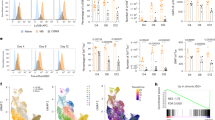Abstract
Allogeneic peripheral stem cell transplantation in six children with non-malignant hematologic or metabolic diseases which are eventually fatal was carried out with parental donors. Given three to five HLA mismatches, all grafts underwent CD34+ cell selection as graft-versus-host prophylaxis. The patients received median doses of 16.7 × 106 CD34+ cells/kg and 1.2 × 104 CD3+cells/kg. All transplants engrafted. Neutrophils >0.5/nl were reached on day 11 (9–19) and platelets >50/nl on day 13 (10–25). Acute GVHD responding to steriods occured in three of six patients; it was restricted to the skin and overall did not exceed grade I. Two patients died of viral infections and four are alive with stable blood counts for 13, 15, 25 and 26 months. For children with non-malignant diseases which will eventually be fatal and which can be cured or ameliorated by allogeneic BMT, CD34+-selected stem cell transplants from mismatched or even haploidentical parents can be used if no other suitable donor is available. With high CD34+ cell doses and low CD3+ cell numbers, engraftment and avoidance of acute GVHD can be expected. Infections after transplantation remain the primary threat to survival.
Bone Marrow Transplantation (2002) 29, 9–13. doi:10.1038/sj.bmt.1703314
This is a preview of subscription content, access via your institution
Access options
Subscribe to this journal
Receive 12 print issues and online access
$259.00 per year
only $21.58 per issue
Buy this article
- Purchase on Springer Link
- Instant access to full article PDF
Prices may be subject to local taxes which are calculated during checkout
Similar content being viewed by others
References
Jabada N, Le Deist F, Cant A et al. Bone marrow transplantation from genetically HLA-nonidentical donors in children with fatal inherited disorders excluding severe combined immunodeficiencies: use of two monoclonal antibodies to prevent graft rejection Pediatrics 1996 98: 420 428
Berenson RJ, Bensinger WI, Hill RS et al. Engraftment after infusion of CD34+ marrow cells in patients with breast cancer or neuroblastoma Blood 1991 77: 1717 1722
Link H, Arseniev L, Bahre O et al. Transplantation allogeneic of CD34+ blood cells Blood 1996 87: 4903 4909
Schumm M, Lang P, Taylor G et al. Isolation of highly purified autologous and allogeneic peripheral CD34+ cells using the CliniMACS device J Hematother 1999 8: 209 218
Schwinger W, Urban C, Lackner H et al. Unrelated peripheral blood stem cell transplantation with ‘megadoses’ of purified CD34+ cells in three children with refractory severe aplastic anemia Bone Marrow Transplant 2000 25: 513 517
Aversa F, Fabilio A, Velardi A et al. Treatment of high risk acute leukemia with T-cell depleted stem cells from related donors with one fully mismatched HLA-haplotype New Engl J Med 1998 339: 1186 1193
Kato S, Yabe H, Yasui M et al. Allogeneic hematopoietic transplantation of CD34+ selected cells from an HLA haplo-identical related donor. A long-term follow-up of 135 patients an a comparison of stem cell source between the bone marrow and the peripheral blood Bone Marrow Transplant 2000 26: 1281 1290
Klingebiel TE, Lang P, Schumm M et al. Current results in haploidentical stem cell transplantation in children Bone Marrow Transplant 2000 25: (Suppl. 1) S1
Lackner A, Basu O, Bierings M et al. Haematopoietic stem cell transplantation for amegakaryocytic thrombocytopenia Br J Haematol 2000 109: 773 775
Kremens B, Basu O, Grosse-Wilde H et al. Transplantation of CD34-enriched peripheral stem cells from an HLA-haplotype mismatched donor to a patient with severe aplastic anemia Bone Marrow Transplant 2001 27: 1111 1113
Uharek L, Gassman W, Glass B et al. Influence of cell dose and graft-versus-host reactivity on rejection rates after allogeneic bone marrow transplantation Blood 1992 79: 1612 1621
Peters CH, Shapiro EG, Anderson J et al. Hurler-syndrome II. Outcome of HLA-genotypically identical sibling and HLA-haploidentical related donor bone marrow transplantation in fifty-four children Blood 1998 91: 2601 2608
Lang P, Handgretinger R, Schlegel PG et al. Transplantation of allogeneic purified peripheral CD34+ stem cells for nonmalignant diseases in children Blood 2000 96: 418a (Abstr. 1796)
Elhasid R, Weyl Ben Arush M, Katz T et al. Successful haploidentical bone marrow transplantation in Fanconi anemia Bone Marrow Transplant 2000 26: 1221 1223
Matsuda Y, Hara J, Osugi Y et al. Allogeneic peripheral stem cells transplantation using positively selected CD34+ cells from HLA-mismatched donors Bone Marrow Transplant 1998 21: 355 360
Author information
Authors and Affiliations
Rights and permissions
About this article
Cite this article
Kremens, B., Basu, O., Peceny, R. et al. Allogeneic CD34+-selected peripheral stem cell transplantation from parental donors in children with non-malignant diseases. Bone Marrow Transplant 29, 9–13 (2002). https://doi.org/10.1038/sj.bmt.1703314
Received:
Accepted:
Published:
Issue Date:
DOI: https://doi.org/10.1038/sj.bmt.1703314
Keywords
This article is cited by
-
Haploidentical SCT in children: an update and future perspectives
Bone Marrow Transplantation (2008)
-
Blutstammzelltransplantation bei Mukopolysaccharidose Typ 1H (Morbus Hurler)
Monatsschrift Kinderheilkunde (2006)
-
Transplantation of allogeneic CD34-selected stem cells after fludarabine-based conditioning regimen for children with mucopolysaccharidosis 1H (M. Hurler)
Bone Marrow Transplantation (2005)
-
T-cell-depleted peripheral blood stem cell transplantation for α-mannosidosis
Bone Marrow Transplantation (2003)



